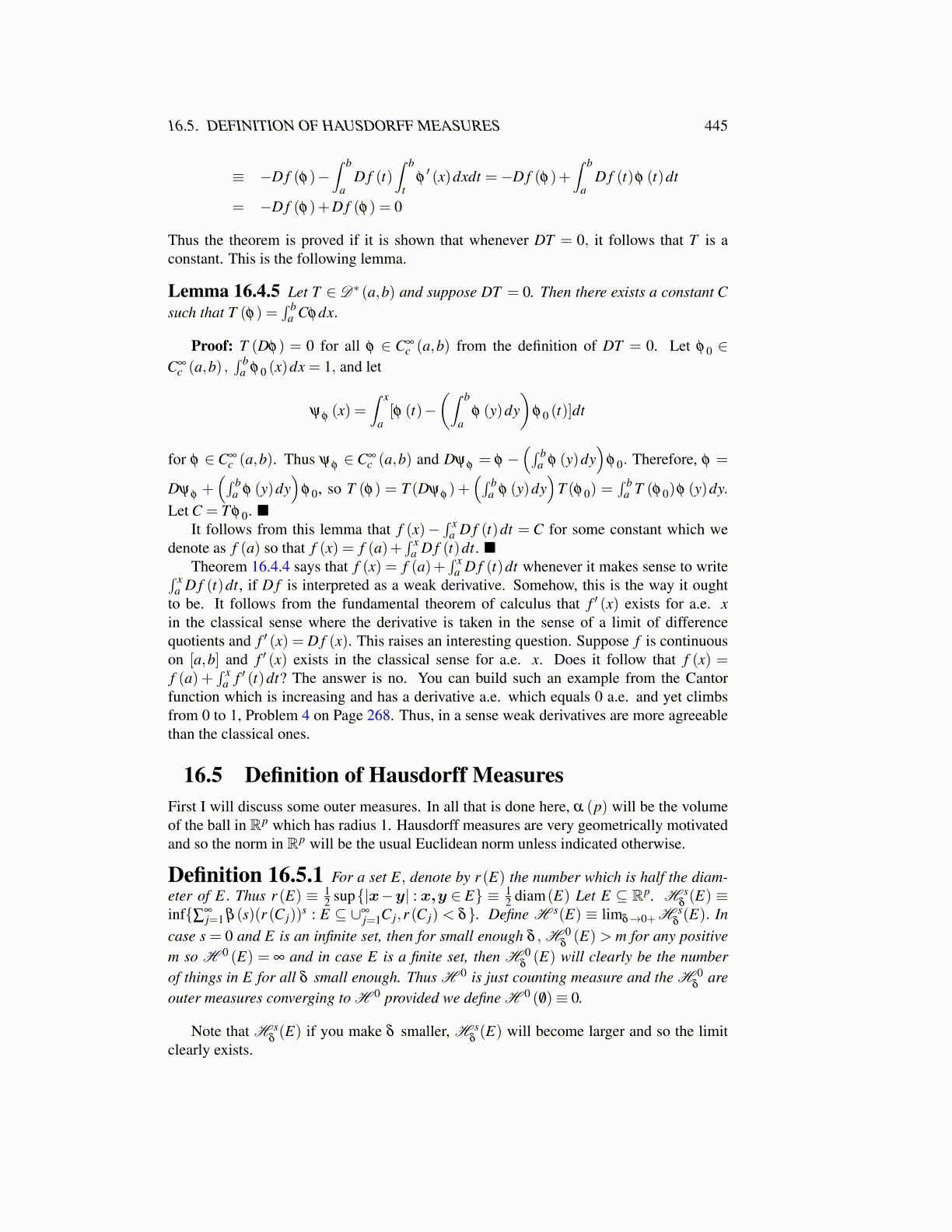
16.5. DEFINITION OF HAUSDORFF MEASURES 445
≡ −D f (φ)−∫ b
aD f (t)
∫ b
tφ′ (x)dxdt =−D f (φ)+
∫ b
aD f (t)φ (t)dt
= −D f (φ)+D f (φ) = 0
Thus the theorem is proved if it is shown that whenever DT = 0, it follows that T is aconstant. This is the following lemma.
Lemma 16.4.5 Let T ∈ D∗ (a,b) and suppose DT = 0. Then there exists a constant Csuch that T (φ) =
∫ ba Cφdx.
Proof: T (Dφ) = 0 for all φ ∈ C∞c (a,b) from the definition of DT = 0. Let φ 0 ∈
C∞c (a,b) ,
∫ ba φ 0 (x)dx = 1, and let
ψφ (x) =∫ x
a[φ (t)−
(∫ b
aφ (y)dy
)φ 0 (t)]dt
for φ ∈ C∞c (a,b). Thus ψφ ∈ C∞
c (a,b) and Dψφ = φ −(∫ b
a φ (y)dy)
φ 0. Therefore, φ =
Dψφ +(∫ b
a φ (y)dy)
φ 0, so T (φ) = T (Dψφ )+(∫ b
a φ (y)dy)
T (φ 0) =∫ b
a T (φ 0)φ (y)dy.Let C = T φ 0. ■
It follows from this lemma that f (x)−∫ x
a D f (t)dt = C for some constant which wedenote as f (a) so that f (x) = f (a)+
∫ xa D f (t)dt. ■
Theorem 16.4.4 says that f (x) = f (a)+∫ x
a D f (t)dt whenever it makes sense to write∫ xa D f (t)dt, if D f is interpreted as a weak derivative. Somehow, this is the way it ought
to be. It follows from the fundamental theorem of calculus that f ′ (x) exists for a.e. xin the classical sense where the derivative is taken in the sense of a limit of differencequotients and f ′ (x) = D f (x). This raises an interesting question. Suppose f is continuouson [a,b] and f ′ (x) exists in the classical sense for a.e. x. Does it follow that f (x) =f (a) +
∫ xa f ′ (t)dt? The answer is no. You can build such an example from the Cantor
function which is increasing and has a derivative a.e. which equals 0 a.e. and yet climbsfrom 0 to 1, Problem 4 on Page 268. Thus, in a sense weak derivatives are more agreeablethan the classical ones.
16.5 Definition of Hausdorff MeasuresFirst I will discuss some outer measures. In all that is done here, α (p) will be the volumeof the ball in Rp which has radius 1. Hausdorff measures are very geometrically motivatedand so the norm in Rp will be the usual Euclidean norm unless indicated otherwise.
Definition 16.5.1 For a set E, denote by r (E) the number which is half the diam-eter of E. Thus r (E) ≡ 1
2 sup{|x−y| : x,y ∈ E} ≡ 12 diam(E) Let E ⊆ Rp. H s
δ(E) ≡
inf{∑∞j=1 β (s)(r (C j))
s : E ⊆ ∪∞j=1C j,r (C j) < δ}. Define H s(E) ≡ limδ→0+H s
δ(E). In
case s = 0 and E is an infinite set, then for small enough δ , H 0δ(E) > m for any positive
m so H 0 (E) = ∞ and in case E is a finite set, then H 0δ(E) will clearly be the number
of things in E for all δ small enough. Thus H 0 is just counting measure and the H 0δ
areouter measures converging to H 0 provided we define H 0 ( /0)≡ 0.
Note that H sδ(E) if you make δ smaller, H s
δ(E) will become larger and so the limit
clearly exists.